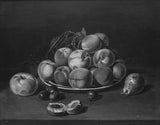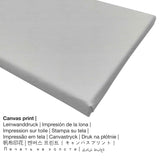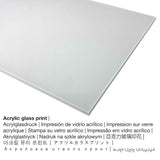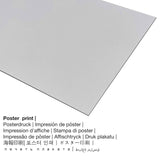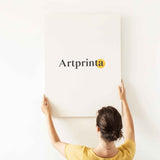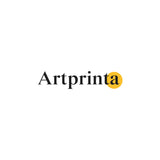John A. Woodside, 1825 - Still Life: Peaches, Apple, na Pear - chapa nzuri ya sanaa
Kodi ni pamoja. Usafirishaji umehesabiwa katika Checkout.
Maelezo ya kina ya bidhaa za sanaa
Hii imekwisha 190 year-old artpiece was created by the artist John A. Woodside in 1825. The masterpiece was made with the size: 9 3/4 x 12 1/4 in (sentimita 24,8 x 31,1) na ilitengenezwa na kati mafuta juu ya kuni. Siku hizi, mchoro huu ni wa mkusanyiko wa Makumbusho ya Metropolitan ya Sanaa. Kwa hisani ya Makumbusho ya Metropolitan ya Sanaa, New York, Mfuko wa Rogers, 1941 (yenye leseni - kikoa cha umma). Zaidi ya hayo, kazi ya sanaa ina nambari ya mkopo: Rogers Fund, 1941. Nini zaidi, alignment ni landscape kwa uwiano wa 4: 3, ambayo ina maana kwamba urefu ni 33% zaidi ya upana.
Chagua lahaja yako ya nyenzo za uchapishaji wa sanaa
Kwa kila chapa ya sanaa tunatoa anuwai ya saizi na nyenzo tofauti. Kwa hivyo, tunakuruhusu kuchagua kati ya chaguzi zifuatazo:
- Chapisho la bango (nyenzo za turubai): The Artprinta poster print is a printed canvas with a fine surface finish. A printed poster is particularly qualified for putting your art replica using a custom-made frame. Please bear in mind, that depending on the absolute size of the poster print we add a white margin of approximately 2-6 cm round about the print, which facilitates the framing with your custom frame.
- Mchapishaji wa dibond ya Alumini: These are metal prints on aluminium dibond material with an outstanding effect of depth. The Aluminium Dibond Print is the excellent introduction to art replicas with aluminum. The print on Aluminum Dibond is one of the most demanded entry-level products and is an extremely modern way to display fine art reproductions, since it puts 100% of the viewer’s focus on the replica of the artwork.
- Uchapishaji wa glasi ya akriliki (na mipako halisi ya glasi): A glossy print on acrylic glass, which is often described as a plexiglass print, changes the original work of art into amazing décor and is a good alternative to aluminium or canvas art prints. Your favorite artwork is being made thanks to modern UV direct print technology. The real glass coating protects your custom art print against sunlight and external influences for several decades.
- Uchapishaji wa turubai: The UV printed canvas mounted on a wooden stretcher frame. A canvas makes the sculptural effect of three dimensionality. A canvas print has the advantage of being relatively low in weight, which means that it is easy and straightforward to hang the Canvas print without extra wall-mounts. Hence, canvas prints are suited for all types of walls.
Important legal note: We try all that we can in order to depict the art products as closely as possible and to illustrate them visually. Nevertheless, the pigments of the printed materials and the imprint might vary to a certain extent from the presentation on your screen. Depending on the settings of your screen and the condition of the surface, colors can unfortunately not be printed as exactly as the digital version. Considering that all the fine art prints are printed and processed by hand, there might also be minor deviations in the motif's size and exact position.
Kuhusu bidhaa hii
| Uainishaji wa bidhaa: | nakala ya sanaa |
| Mbinu ya uzazi: | uzazi wa kidijitali |
| Mbinu ya utengenezaji: | Uchapishaji wa moja kwa moja wa UV (uchapishaji wa dijiti) |
| viwanda: | Imetengenezwa kwa Ujerumani |
| Aina ya hisa: | juu ya mahitaji |
| Matumizi yaliyokusudiwa ya bidhaa: | mapambo ya ukuta, muundo wa nyumba |
| Mpangilio: | muundo wa mazingira |
| Uwiano wa picha: | 4 : 3 - (urefu: upana) |
| Maana ya uwiano wa picha: | urefu ni 33% zaidi ya upana |
| Nyenzo unaweza kuchagua: | chapa ya turubai, chapa ya chuma (dibond ya alumini), chapa ya glasi ya akriliki (iliyo na mipako halisi ya glasi), chapa ya bango (karatasi ya turubai) |
| Turubai kwenye fremu ya machela (chapisho la turubai) lahaja za ukubwa: | 40x30cm - 16x12" |
| Chapa ya glasi ya akriliki (iliyo na mipako halisi ya glasi) anuwai: | 40x30cm - 16x12" |
| Ukubwa wa bango (karatasi ya turubai): | 40x30cm - 16x12" |
| Uchapishaji wa Dibond (nyenzo za alumini): | 40x30cm - 16x12" |
| Muafaka wa picha: | nakala ya sanaa isiyo na fremu |
Data ya usuli kwenye mchoro wa kipekee
| Kichwa cha uchoraji: | "Still Life: Peaches, Apple, and Pear" |
| Uainishaji wa kazi ya sanaa: | uchoraji |
| Uainishaji wa sanaa: | sanaa ya kisasa |
| Wakati: | 19th karne |
| Mwaka wa uumbaji: | 1825 |
| Takriban umri wa kazi ya sanaa: | miaka 190 |
| Imechorwa kwenye: | mafuta juu ya kuni |
| Vipimo vya mchoro wa asili: | 9 3/4 x 12 1/4 in (sentimita 24,8 x 31,1) |
| Makumbusho / eneo: | Makumbusho ya Metropolitan ya Sanaa |
| Mahali pa makumbusho: | New York City, New York, Marekani |
| Ukurasa wa wavuti wa Makumbusho: | Makumbusho ya Metropolitan ya Sanaa |
| Aina ya leseni ya uchoraji: | Uwanja wa umma |
| Kwa hisani ya: | Makumbusho ya Metropolitan ya Sanaa, New York, Mfuko wa Rogers, 1941 |
| Nambari ya mkopo: | Rogers Fund, 1941 |
Maelezo ya jumla kuhusu msanii
| Artist: | John A. Woodside |
| Majina ya ziada: | John A. Woodside, John Archibald Woodside |
| Jinsia ya msanii: | kiume |
| Raia wa msanii: | Marekani |
| Kazi za msanii: | painter, history artist, artist |
| Nchi ya msanii: | Marekani |
| Uainishaji wa msanii: | msanii wa kisasa |
| Uzima wa maisha: | miaka 71 |
| Mzaliwa: | 1781 |
| Mji wa Nyumbani: | Philadelphia, kaunti ya Philadelphia, Pennsylvania, Marekani |
| Mwaka ulikufa: | 1852 |
| Mji wa kifo: | Philadelphia, kaunti ya Philadelphia, Pennsylvania, Marekani |
© Copyright - www.artprinta.com (Artprinta)
Maelezo ya jumla na Makumbusho ya Sanaa ya Metropolitan (© - Makumbusho ya Sanaa ya Metropolitan - Makumbusho ya Metropolitan ya Sanaa)
Woodside probably received his training from Philadelphia sign painter Matthew Pratt or one of Pratt’s business partners. In 1805, Woodside opened his own studio in Philadelphia, advertising his services as an ornamental or sign painter. He aspired to less mundane genres, however, and tried his hand at emblematic and patriotic works, animal scenes, miniatures, and copies after English engravings. This work and its companion, "Still Life: Peaches and Grapes" (41.152.1), are among Woodside’s few known still lifes and represent his best efforts as a painter. His arrangement of the fruit in a spare setting bears the stylistic imprint of the Peale family, who established a still-life tradition in Philadelphia in the early nineteenth century.

